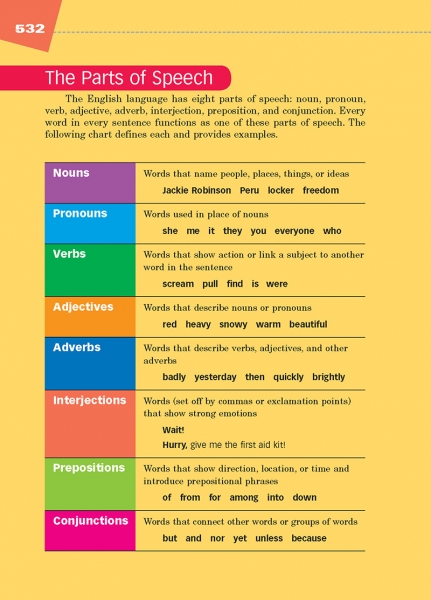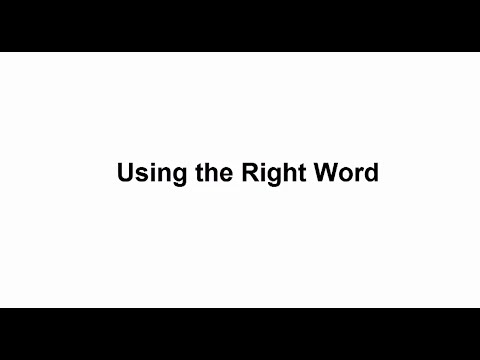Page 532 from

Start-Up Activity
Read off the eight parts of speech to your students. Afterward, ask if they feel overwhelmed. They have a right to: Eight of anything is a lot to keep track of. Help simplify the parts of speech graphically.
-
On the board, write "Noun" and circle it. Then ask, "What is a noun?" Most students can recite that it is a person, place, or thing (or idea).
-
To the right of it, write "Verb" and circle it. Then ask "What is a verb?" Most students will be able to say that it is an action or state of being.
-
Draw a line to connect the noun to the verb. "That is a sentence. Noun and verb. Subject and predicate."
-
Ask what a pronoun is. Students will probably be able to say that it takes the place of a noun (or other pronoun). Point to "Noun" but do not write "Pronoun."
-
Ask what an adjective is. Students will say that it modifies a noun. Write "Adjective" to the left of "Noun."
-
Ask what an adverb is. Students will say that it modifies a verb (or adjective or other adverb). Write "Adverb" to the right of "Verb."
-
Ask what an interjection is. Students will say that is shows emotion. Say, "Oh. How nice." Point out that the two things you just said are interjections. They are so unimportant, you won't even write the word down.
-
Ask what a preposition is. Students may not be able to tell. Say that it is a word that creates a phrase that functions as an adjective or adverb. Point at those two words but don't write down "Preposition."
-
Ask what a conjunction is. Students will probably say that it is a joining word. Don't write it down.
Point back to your diagram. The parts of speech really boil down to nouns, verbs, and modifiers. Remembering three things is much easier than remembering eight.
Think About It
“The adjective is the banana peel of the parts of speech.”
—Clifton Fadiman

Start-Up Activity
Read off the eight parts of speech to your students. Afterward, ask if they feel overwhelmed. They have a right to: Eight of anything is a lot to keep track of. Help simplify the parts of speech graphically.
-
On the board, write "Noun" and circle it. Then ask, "What is a noun?" Most students can recite that it is a person, place, or thing (or idea).
-
To the right of it, write "Verb" and circle it. Then ask "What is a verb?" Most students will be able to say that it is an action or state of being.
-
Draw a line to connect the noun to the verb. "That is a sentence. Noun and verb. Subject and predicate."
-
Ask what a pronoun is. Students will probably be able to say that it takes the place of a noun (or other pronoun). Point to "Noun" but do not write "Pronoun."
-
Ask what an adjective is. Students will say that it modifies a noun. Write "Adjective" to the left of "Noun."
-
Ask what an adverb is. Students will say that it modifies a verb (or adjective or other adverb). Write "Adverb" to the right of "Verb."
-
Ask what an interjection is. Students will say that is shows emotion. Say, "Oh. How nice." Point out that the two things you just said are interjections. They are so unimportant, you won't even write the word down.
-
Ask what a preposition is. Students may not be able to tell. Say that it is a word that creates a phrase that functions as an adjective or adverb. Point at those two words but don't write down "Preposition."
-
Ask what a conjunction is. Students will probably say that it is a joining word. Don't write it down.
Point back to your diagram. The parts of speech really boil down to nouns, verbs, and modifiers. Remembering three things is much easier than remembering eight.
Think About It
“The adjective is the banana peel of the parts of speech.”
—Clifton Fadiman


